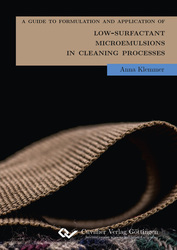| Areas | |
|---|---|
| Serie de libros (96) |
1378
|
| Nachhaltigkeit |
3
|
| Gesundheitswesen |
1
|
| Letra |
2365
|
| Ciencias Naturales |
5406
|
| Matemática | 229 |
| Informática | 319 |
| Física | 980 |
| Química | 1363 |
| Geociencias | 131 |
| Medicina humana | 243 |
| Estomatología | 10 |
| Veterinaria | 108 |
| Farmacia | 147 |
| Biología | 835 |
| Bioquímica, biología molecular, tecnología genética | 121 |
| Biofísica | 25 |
| Nutrición | 45 |
| Agricultura | 1004 |
| Silvicultura | 201 |
| Horticultura | 20 |
| Ecología y conservación de la tierra | 148 |
| Ciencias Ingeniería |
1793
|
| General |
98
|
|
Leitlinien Unfallchirurgie
5. Auflage bestellen |
|
Erweiterte Suche
A Guide to Formulation and Application of Low-Surfactant Microemulsions in Cleaning-Processes (Tienda española)
Anna Klemmer (Autor)Previo
Indice, PDF (56 KB)
Lectura de prueba, PDF (360 KB)
Surfactants were and still are our inconspicuous companions at macroscopic but more often at microscopic scale. Many technologies are only possible due to surfactant applications, which are of constantly growing scientific and industrial interest for approximately 100 years 1. Hence, since its definition ‘micro emulsion’ by Schulman 2 optically isotropic surfactant formulations and their variations have become a significant part in today’s society. In nowadays’ most popular sector of nanomaterials surfactants are utilised for productions of such via template strategies [3–10]. Organic synthesis benefits from the immensely huge interfacial area of microemulsions resulting in bigger yields which were not possible before [11–21]. Closely related to organic synthesis, pharmaceutical industries enjoy the benefits of drug delivery via e.g. vesicels which play a major role during drug transport into the blood stream [22–27]. Simpler application of surfactants were reported 1984 where cationic surfactants were utilised as stabiliser for antibiotics 28. Concerning healthier and conscious nutrition microemulsions are applied for reduction of the caloric value of food [29–39]. Also, to contribute to environmental protection exhaust emissions can be reduced by introducing water and surfactants into fuels [40–42]. Surfactant systems or in most cases microemulsions are very adaptable and can therefore be utilised in their most different states. This chapter gives an insightful introduction into the world of microemulsions.
| ISBN-13 (Impresion) | 9783954048977 |
| ISBN-13 (E-Book) | 9783736948976 |
| Formato | A5 |
| Idioma | Inglés |
| Numero de paginas | 200 |
| Laminacion de la cubierta | Brillante |
| Edicion | 1. Aufl. |
| Lugar de publicacion | Göttingen |
| Lugar de la disertacion | Köln |
| Fecha de publicacion | 17.12.2014 |
| Clasificacion simple | Tesis doctoral |
| Area |
Físicoquimica
|
| Palabras claves | microemulsions, nanoemulsions, low-energy method, low-surfactant concentration, cleaning surfaces |








